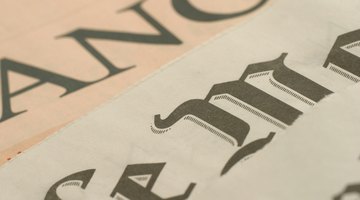The Mirror, at the end of 2012, reported that, “ITV's new logo [had been] ridiculed on Twitter,” and that a number of people had tweeted how it resembled, “a bottom or even an Ann Summers sex toy.” This only goes to show how important a logo design is for any business and how even huge, supposedly highly-experienced companies can get it wrong on tragic proportions. Some logos are more appealing than others and better transmit the company's ideals. The good news is that it is possible to analyse a logo, whether the end goal be related to marketing or academic goals.
Study the overall look and feel of the logo. Logos can sometimes be serious in nature, sometimes the can inspire confidence and trust, others make the audience feel happy and some are particularly entertaining that they evoke smiles and even laughter. First impressions are important when analysing a logo. Think less and let your subconscious take over. This will help you to get an overall feeling for the logo and the intentions behind it. You will better see the purpose of the logo and the effect that the designer is hoping to achieve when you rely less on the analytical part of your brain.

Focus on the colours in the logo. If there’s more than one colour, one will probably be more important or more dominant than the rest. That colour might evoke a reaction in you. It might be repellant or attractive. It might make you feel calm or generate a sense of excitement. There have been a number of psychological studies into the effects of colour on the human brain and the results of these studies reveal vital information which marketers and designers use when creating logos for their businesses. Red stimulates the brain and appears much closer to the audience than it actually is. Blue, on the other hand, has a calming effect on the human brain and is considered to be reflective of intelligence. To analyse logos on a deeper level, it would be a good idea to read up a little on colour psychology.
- Focus on the colours in the logo.
- That colour might evoke a reaction in you.

Look at the basic shape of the logo. Logos in the shape of squares or circles are simpler constructions which the human brain deciphers quicker than it does with rectangles or triangles. Look at a series of different-shaped logos side by side and notice the difference in impact. The simpler logos are bound to draw your attention more, particularly if the main colour used happens to be red. Find a series of triangular-shaped logos to analyse. Many studies reveal that triangles are more aggressive than the other basic shapes. The pointed edges of a triangle can make a logo more dynamic and energetic. Run a quick test by changing the famous circle logo of the Coca Cola brand into a triangle and notice how the dynamic of the logo is altered.
- Look at the basic shape of the logo.
- Run a quick test by changing the famous circle logo of the Coca Cola brand into a triangle and notice how the dynamic of the logo is altered.

Find a series of logos which feature mascots or symbols and lay them out on a table. When analysing the use of mascots and symbols in logos it is essential to take context into consideration. For example, the mango is the national fruit of India and its leaves are used in a number of religious ceremonies. A logo meant for an audience in India which utilises the mango will signify something very different to a mango used in the UK by an organic food company, for instance. You must have an awareness of context when analysing the use of mascots and symbols in logos.

Study the fonts used. Fonts can be bold, italicised, simple or complex in nature. A bold, large font is meant to convey a very different company image to that of a delicate, italicised font. It’s also a really good idea to analyse font choice alongside the use of colour. Some logos use bold colours and bold fonts, denoting a bold company in every respect, but some logos use bold colours which contrast against delicate fonts. Make notes about on the combination of font style and colour to help you decipher what kind of image the company is trying to create for itself.
- Find a series of logos which feature mascots or symbols and lay them out on a table.
- Make notes about on the combination of font style and colour to help you decipher what kind of image the company is trying to create for itself.

Search for competing logos. A really good way of analysing a logo’s effectiveness is to place it alongside a range of other business logos, clearly competing to attract the same or a similar audience. Make sure you find logos that are looking to attract the same demographic and that are looking to project a similar kind of image. Don’t just opt for logos which are selling the same products or working within the same industry. Product line and industry category doesn’t immediately put two businesses in competition with each other. Find those companies which are trying to appeal to the same demographic using a similar style and approach. Compare the effect of the logo you are looking at with these other logos to gauge just how successful one logo is over the others.
- Search for competing logos.
- Make sure you find logos that are looking to attract the same demographic and that are looking to project a similar kind of image.
TIP
- Research a little into colour psychology or perhaps take a short course in artistic design
WARNING
- Avoid bringing what you already know about the company behind the logo to your analysis. Look at each element of the logo in turn and remain as objective as possible. This is the best way to analyse the true effect a logo might have on its target audience
